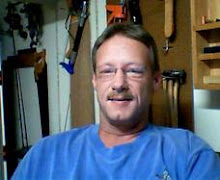
Small squares, be they combination squares or fixed machinists squares, are staples in the wood shop. The proper use of such squares is critical in obtaining square stock and square joints. I learned this the hard way when first venturing forth into the world of working wood.
At first, I used the arm of the square, instead of the base, to check for square. Of course, everything looked square....until I tried to put it together. Only then, did I find out that I must have been using the square incorrectly.
Here's a picture of how I was using the square incorrectly. Notice how the arm(beam) of the square(the vertical part in the picture) is flush to the end of the board, but the base(the part with the logo on it) is out of square. If you only look at the long arm, you'll be sorely disappointed.

The following photos demonstrate the proper way to use a square. In this first photo below, notice that I have the base of the square flush with the side of the board and away from the end of the board. In this fashion, I can now ensure that I'll be measuring the end of the board for square in relation to the side.

The next picture demonstrates the second correct position. Notice that the base of the square is still flush with the side of the board and I have simply slid the long arm of the square into contact with the end of the board. In this case, the end of the board is square to the side. At least my table saw is set up correctly. LOL

This last photograph shows the same board, now intentionally cut out-of-square. I've used the same technique to keep the base of the square flush with the side of the board and the out of square end is easily demonstrated.

The last thing to mention about using these dmall squares is this. After the base of the square is flush with the side, s-l-o-w-l-y slide the long arm of the square until it just touches the end of the board. Do not force the long arm of the square after it has touched the end of the board If you do, you'll get an inaccurate reading. Trust me on this, I know!!!
I hope this short tutorial makes using the squares in your shop more accurate and more pleasurable.
Remember, without a push from a user, a plane is an expensive decoration and not a tool.

No comments:
Post a Comment